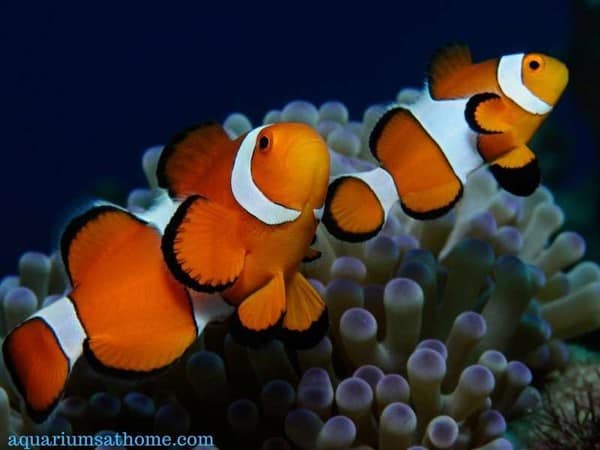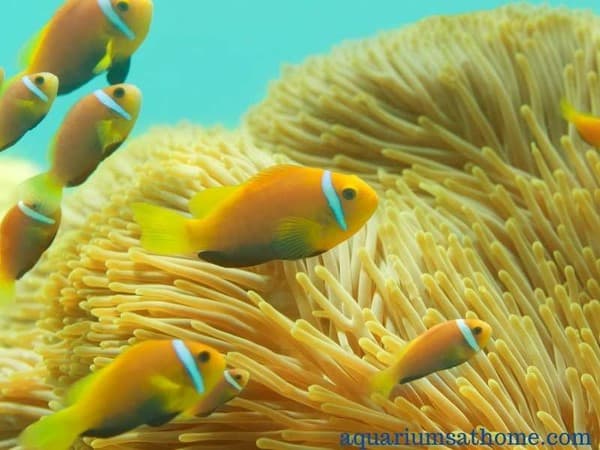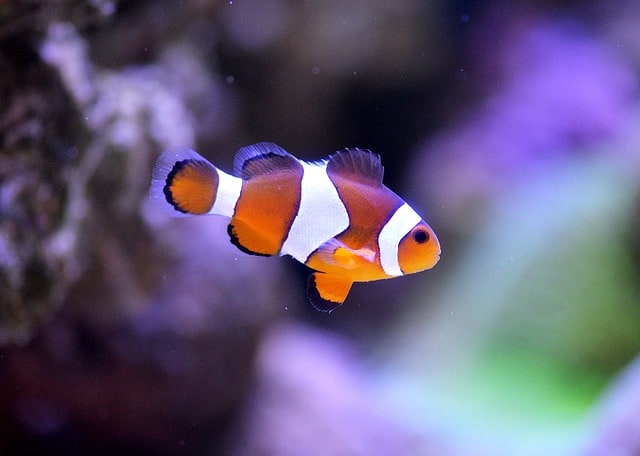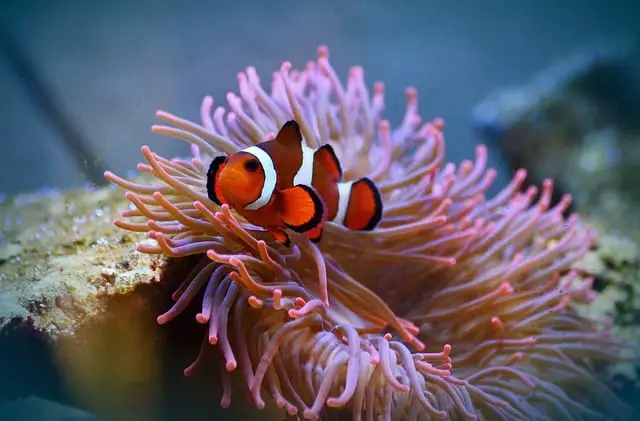Clownfish are beloved by many and best known for being featured in the ‘Finding Nemo’ cartoon by Disney! Saltwater aquarium hobbyists have favored this species for years because of their bright colors, active nature, and social habits. But what happens if a lone female clownfish dies in an aquarium?
If a female clownfish dies in captivity, the dominant male will naturally change gender and become female to replace her. The largest of the remaining smaller males will then become the new dominant male in the group and try to pair up with the female. This hermaphroditic ability is the species way of ensuring its survival.
Now that you know a male clownfish will change sex and become female should the lone female die in an aquarium, let’s explore this topic in more detail. I’ll explain why captive clownfish die, if they mate for life, and will they mourn their dead. I’ll also discuss how they reproduce and what to do to encourage successful breeding.
So, if you’re ready to learn more about the fascinating hermaphroditic clownfish and their mating, breeding and social behaviors, then let’s get to it!
Why Did My Clownfish Die?
The main reason clownfish die in captivity is due to stress. If the water parameters (especially the pH) are ‘off’ or the fish aren’t properly acclimated to the tank in the first place, they’ll often parish within the first year of aquarium life.
Another reason could be illness. A parasitic organism will often result in clownfish death while in captivity. The infestation of brooklynella hostilis or ‘clownfish disease’ must be treated properly and completely to ensure survival of this fish species.
A third cause of clownfish death in an aquarium is starvation. If the fish aren’t fed enough, they won’t live long in captivity. A nutritious diet consisting of both plant- and meat-based foods (given twice a day) will improve health and sustain this omnivorous species.
Can a Male Clownfish Turn Female?
All clownfish are born male however, they carry both male and female reproductive organs. A dominant male can change gender to replace an alpha female should she die prematurely in captivity. It’s believed the hermaphroditic nature of the clownfish is linked to its symbiotic relationship with the sea anemone.
Can a Female Clownfish Turn Male?
Once a male clownfish changes gender, it can’t revert back. Therefore, a female clownfish remains female for life. The largest male will try to unite with the dominant female in an aquarium and if they bond, they’ll become a monogamous, mated pair.
What Happens When a Clownfish Partner Dies?
When a female clownfish dies, the male switches gender and becomes female to take on the necessary role of protecting territory and producing offspring. Role reversal is synonymous with this species – in fact, when eggs are laid, it’s the female that wards off threats while the male stands guard!

How Long Does It Take a Male Clownfish to Turn Female?
Following the death of a female partner, a male clownfish will turn female a short time later – 2 to 4 weeks is all it takes on average. Profound biological changes occur in which the testes dissolve and the ovaries are formed.
Will a Solitary Clownfish Still Change Sex?
A clownfish alone in an aquarium will likely not change sex. Switching from male to female occurs when you have a group of clownfish together (or a mated pair) and the lone female dies. The natural desire to mate and reproduce is what triggers this gender change.
Does Changing Sex Increase Aggression in Clownfish?
When a male clownfish changes gender and becomes female, aggression levels may rise in an aquarium. The once submissive male that was formerly the target of attack by the dominant female now becomes the aggressor as it begins to court the smaller fish. Nipping of fins and chasing each other are common.
Do Clownfish Mate for Life?
Clownfish are monogamous and will mate for life. They’ll choose a single breeding and remain a mated pair until death. Should the female die first, then the male will flip gender and become female to replace her. This behavior is thought to be the result of living in small spaces like sea anemones.
Do Clownfish Mourn?
Clownfish don’t ‘mourn’ the death of a mated partner. Within weeks of the female dying, a male will change gender and continue life as a female – looking to reproduce with another male, which then becomes its new mate. If the male dies, a female will pair with a new male, bond, and procreate.
How Do Clownfish Reproduce?
Clownfish are egg depositors and reproduce by laying eggs in batches next to their sea anemone or on rocks/coral in an aquarium. Spawning begins with typical behaviors such as the male chasing the female and the female asserting dominance over the male by nipping at his fins.
Clownfish reproduce sexually through external fertilization. Females lay hundreds of eggs in a single spawning event. Once laid, the male guards and protects the eggs until they hatch. After hatching, the parents play no part in rearing their offspring.
How to Encourage Successful Clownfish Breeding?
Getting clownfish to breed in captivity is no easy feat. However, with some care and a little ‘know-how’, it can be done successfully. These 5 basic steps to encourage clownfish to spawn and reproduce in an aquarium which include the following:
- Start with a mated pair – purchase a male and female at the same time from the same tank. Most fish stores will sell bonded pairs of clownfish specifically for the purpose of breeding.
- Ensure the water parameters are correct –clownfish are highly-sensitive to changes in their environment. Fluctuating water conditions lead to stress, making it difficult for them to breed.
- Add an anemone to the tank – the symbiotic relationship between anemones and clownfish will help mated pairs feel safe, thus encouraging them to breed.
- Adjust the aquarium light – less hours of light (8 instead of the typical 10 or 12) per day will help as clownfish eggs tend to hatch at night.
- Feed mated pairs an omnivorous diet – offering clownfish a variety of nutritious plant- and meat-based foods twice a day will promote health and encourage breeding.
The key to successful clownfish breeding – in most cases – is patience. If you’ve provided your mated pair with everything they need (as listed above), then all you can do in the meantime is watch and wait! Setting up a hatchling tank in the interim is recommended.

How Do You Replace a Mated Clownfish?
To replace a mated clownfish, start by purchasing a much smaller male to pair with a lone female. A juvenile would be ideal as he hasn’t reached sexually maturity yet, making it easier for the two to bond. Once a male clownfish changes to female, it can’t revert back so make sure you get a male! Otherwise, the two may become aggressive and fight each other for dominance or territory.
Conclusion
To summarize, clownfish are hermaphroditic – meaning they are all born male and will change gender to procreate. Should a lone female clownfish die in captivity, for example, the dominant male will mutate and replace her. As a result, the second largest male will become the new dominant male in the tank.
I hope this article has answered your questions regarding the reproductive and social habits of the clownfish. Thanks for reading and good luck with your aquarium hobby.
Related Posts
Which Clownfish can be Kept Together?
Clown Fish Tank Set Up for Beginners
How to Get Rid of a Dead Fish? (Do it Right)
Can You Have 3 Clownfish in a Tank?
Clownfish Brooklynella Symptoms (How to Treat Your Clownfish)




